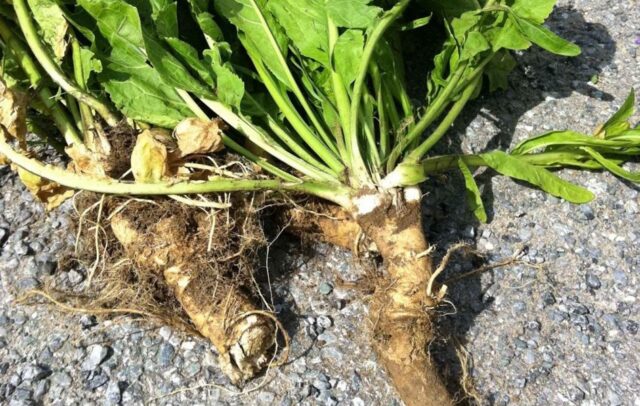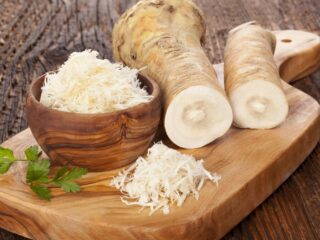Content
Replanting horseradish is not difficult; even an inexperienced gardener can do this work. The culture is completely unpretentious and requires minimal care. Many gardeners consider it a weed and note that it is much more difficult to remove it from the site than to plant it. To propagate horseradish, a small root is usually enough, so in order to transplant it correctly, it is important to remove the plant completely from the soil when digging, without leaving a single piece.

Horseradish has a creeping root system, which, if not properly cared for, can fill large areas
Why is a transplant needed?
Various sources say that the crop does not require either care or a change in location and can remain in the garden for more than ten years, but many gardeners note that it is better to replant horseradish at least once every two years. They recommend doing this so that the plant does not turn into a weed and go wild. If it is grown as an annual crop, it will not be able to grow much and send its branchy roots deep into the ground.
When can you transplant horseradish to another place?
Recommendations for planting and caring for the crop say that transplanting horseradish in the spring is considered more favorable, although this requirement is not mandatory. In principle, it is allowed to plant the plant in open ground from April until the last days of October. In the summer, people rarely decide to replant a crop, only when an urgent need arises. In the fall, they prefer to plant horseradish with its roots at the time of harvest. The best month for this procedure is October. If you transplant horseradish at this time, it will grow sharp and burning, its roots will gain mass, become large and strong even without special care. In addition, the plant will receive good hardening and will not suffer from spring frosts.
There is another way to replant a perennial, which involves storing it in the cellar throughout the winter. That is, in the fall, all the roots are removed from the ground, and with the arrival of spring, cuttings are planted on the site.

The plant usually easily tolerates a change of location and quickly takes root.
How to properly transplant horseradish root from one place to another
Knowing how to plant horseradish in the garden in the fall and spring is necessary in order to do all the work correctly and prevent the perennial from turning into a weed. During the procedure, it is important to consider several nuances:
- choose a suitable location;
- pre-prepare the site;
- divide the bush in accordance with the requirements of agricultural technology.
In order for horseradish to bring maximum benefits, in addition to all of the above, it is advisable to provide it with proper care.
Selection and preparation of a site
Despite the fact that the majority of gardeners are accustomed to considering horseradish an aggressive crop that does not need care in order to get a good and high-quality harvest, it also requires attention. It is necessary to transplant the roots to a place well lit by the sun. The plant is light-loving and does not do well in the shade.
It is better to choose moderately fertile soil for the crop, and before replanting it, add manure, compost or mineral fertilizers to the hole. It is advisable to place the bed away from fruit trees so that when digging up perennials, their root system is not damaged. Also, proximity to strawberry plantations is not allowed, otherwise you should not expect a good harvest of berries.

The best precursors for burning roots are legumes and potatoes.
How to split
In order to avoid having to carefully care for the perennial in the future, but still get a high-quality harvest, it is important not only to replant it correctly, but also to divide it. Results can only be achieved by using good planting material.
To divide the dug out bush, cut off the side roots, which should be approximately 30 cm long and 10 mm thick. Next, making an oblique cut, mark the top of each cutting so as not to plant it upside down. Remove the buds from the middle part of the root, leaving a few pieces below and above, from where the leaves and root system will subsequently form.
If the cuttings are not planned to be transplanted immediately, then they are placed in a box filled with sand and stored in a cool room until planting.
Landing at a new place
Transplanting horseradish to a new place in the fall and spring is carried out according to the same algorithm:
- The plant that is about to be transplanted is dug up entirely, after which the place where it grows is carefully examined. Even the smallest parts of the roots should not remain in the soil.
- Thick rhizomes are separated from the bush for further processing, and thin ones are cut into cuttings.
- Place them in a pre-prepared planting hole, about 40 cm deep.
- Cover with soil and water.
- Dig a fence around the planting site to a depth of at least 0.4 m.
Sometimes summer residents plant perennials in containers, barrels, boxes, deep buckets, and thus take care of them. In this case, it is possible to limit the root system of the crop and prevent its spread throughout the site.

Some gardeners plant horseradish not with cuttings, but with green tops
Further care
In order to reap a good harvest every year, the crop should be properly cared for. It is advisable to water on time, remove flower stems and weak leaves, monitor the appearance of weeds in the garden bed and pull them out in time. Some vegetable growers, when the first horseradish sprouts appear, thin out the plantings, leaving the strongest shoots. To make it easier to replant the perennial, in June it is recommended to remove the top layer of soil, cut off all the side branches of the plant and compact the soil back.
Another basic rule of care is loosening.It is held three times per season:
- at the moment of emergence of seedlings by 8 cm;
- when reaching a height of 20 cm by 12 cm;
- when thick leaves are formed at 15-18 cm.
As for fertilizing, the perennial does not really need it, but if desired, you can water it with complex compounds several times over the summer. It is useful to fertilize with ammonium nitrate, superphosphate and potassium salt mixed in equal parts.
Since horseradish has excellent frost resistance and is able to withstand temperatures down to -45 °C, it does not require care for shelter for the winter.
Conclusion
Replanting horseradish is not difficult even for novice gardeners. This plant perfectly tolerates all the work associated with its planting. The culture requires virtually no care; it grows and develops well in any conditions. Quite a lot of farmers grow horseradish; it is often used in cooking as an original spice for dishes, and is also used in folk medicine and even in cosmetology.








